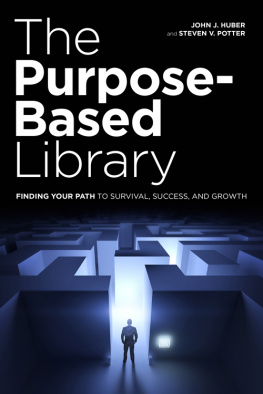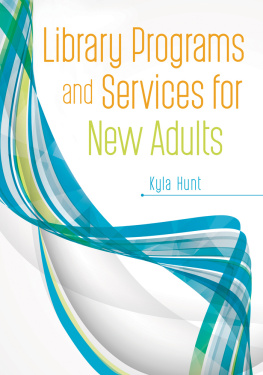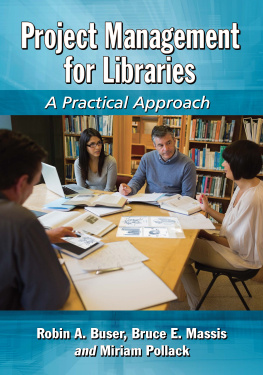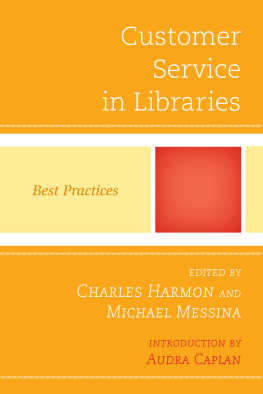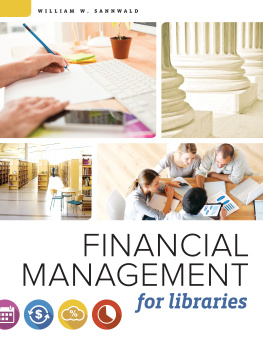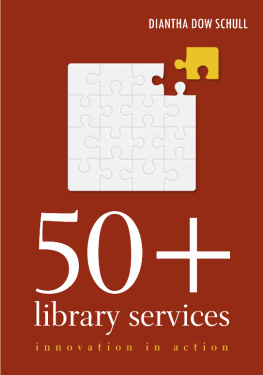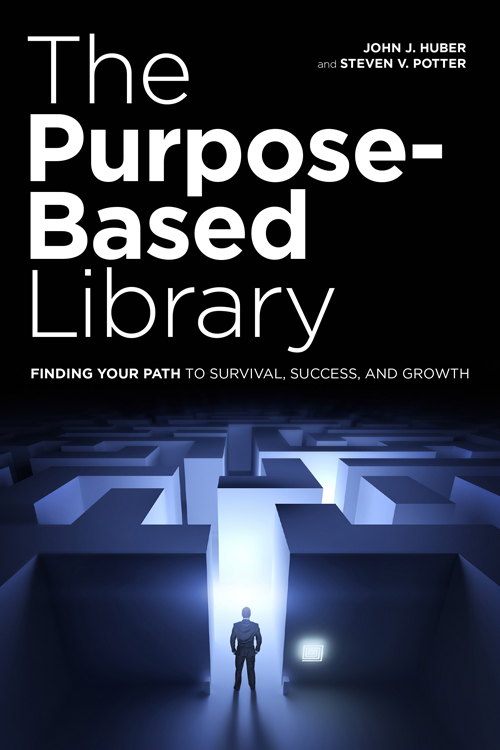
ALA Neal-Schuman purchases fund advocacy, awareness, and accreditation programs for library professionals worldwide.

2015 by the American Library Association
Extensive effort has gone into ensuring the reliability of the information in this book; however, the publisher makes no warranty, express or implied, with respect to the material contained herein.
ISBN: 9780-838912447 (paper)
ISBN: 978-0-8389-1302-4 (PDF)
ISBN: 978-0-8389-1303-1 (ePub)
ISBN: 978-0-8389-1304-8 (Kindle)
Library of Congress Cataloging-in-Publication Data
Huber, John J., 1958
The purpose-based library : finding your path to survival, success, and growth / John Huber, Steven V. Potter.
pages cm
Includes bibliographical references and .
ISBN 978-0-8389-1244-7 (print : alk. paper) 1. Library administration. 2. LibrariesCost control. 3. Public services (Libraries) 4. Organizational change. 5. Organizational effectiveness. I. Potter, Steven V. II. Title.
Z678.H844 2015
025.1dc23
2014046363
Cover design by Kimberly Thornton. Images solarseven/Shutterstock, Inc.
Contents
CARRIE COOGAN
Director, CEO of Literacy Kansas City
Missouri
Literacy for All
A s a young child growing up in a family of seven children, some of my fondest memories are of trips to the library. It happened every week. We would all pile into the car, and thats when my imagination immediately began to run wild with possibilities. What would be happening at the library today? Storytime? Puppet show? Arts and crafts? What interesting books would I find this time tucked away in the shelves? What intriguing places would I visit, what people would I meet, would I learn how to sew or draw, garden, cook a pizza, or write a poem? In a middle-class family of seven children, there are very, very few choices, but at the library the options were endless, exciting, and always an adventure. I could choose anything I wanted to learn or any destination I wanted to travel and meet people from the past or the present. A trip to the library, for me, my brothers and sisters, and yes, even my mom, was a window to the world. A chance to learn, grow, and expand our horizons.
Those days, simple as they sound, have turned out to be the foundation of my education and love of reading.
So when I hear the reports and rumblings of how libraries are fighting extinction and working on ways to stay relevant, it feels heartbreaking, like someone is attacking a cherished friend, a family member, a partner in crime. Yet, the powerful emergence of technology has forced library leaders to look more closely at how they are serving their clients in a way that continues to be exciting and energizing and bring value to the community. Today, as director of the nonprofit organization Literacy Kansas City, my mission is to help people ages 16 and older learn to read. In this position I now see reading and the vital and critical role of libraries from a much different perspective. The services, programs, and access that libraries can provide through community partnerships are now for many people the only resource they may have. At Literacy Kansas City we see every day the struggles that come with illiteracy. Millions of peopleone in five in the nationcant read above a fourth-grade level. As one nonprofit, we cant reach this population alone, but we can make a difference, reach them in their neighborhoods where they feel most comfortable and familiar, and change liveswith the help of libraries. Libraries provide the infrastructure, resources, outreach, technology, and the open, welcoming arms that people who cant read so desperately need. The libraries of today, through creative collaboration with nonprofit organizations like Literacy Kansas City, provide a whole new model for community learning. In our partnerships with the local libraries we are able to reach families, teens, and adults where they live. At neighborhood libraries Literacy Kansas City provides computer-based digital and literacy skills classes enabling both adult and teen students to learn how to read while using a computer. We teach reading, writing, financial, and digital life skills, as well as facilitate tutoring and family reading programs. Other nonprofits need the libraries to help deliver their services to other clients, like English language learners and senior citizens, and provide workforce readiness skills classes as well as GED courses. Strong partnerships allow libraries and nonprofits to focus on and provide the services they need at a particular branch or communityone area may not need a heavy dose of digital life skills classes for senior citizens but they may desperately need a program for adult literacy classes. Not only does this allow libraries and nonprofits to work in concert to serve the needs of their clients where they are, but its more efficient, as resources and staff are shared and services arent being duplicated. The programs fit the needs of the people and, with collaboration and partnerships, libraries become the nerve centers and hubs that help build stronger, smarter communities and, where needed, provide a way out of illiteracy and poverty for their citizens.
Today, I see our library leaders not struggling with, but adapting to this time of change and working on ways to face it head on. John Huber and Steve Potter provide a framework for libraries to continue to lead into the 21st century by being lean, flexible, and adaptable and on a never-ending quest to serve the needs of the community in a valuable way. They are creating a vision that shows how libraries are now more vital than ever when it comes to uniting and lifting a community up and infusing a lifelong love of learning into every citizen.
JOHN J. HUBER
It was the best of times, it was the worst of times, it was the age of wisdom, it was the age of foolishness, it was the epoch of belief, it was the epoch of incredulity, it was the season of Light, it was the season of Darkness, it was the spring of hope, it was the winter of despair, we had everything before us, we had nothing before us....
Charles Dickens, A Tale of Two Cities
O ne might argue that reduced budgets, aggressive competition, the rapid pace of technology, management outsourcing, unfriendly publishers, skeptical city managers, and ever-increasing customer expectations have created the worst of times for libraries. In this book we propose that libraries are poised to create the best of times. Before we explore this potential, let us first examine the state of our current times. During my travels across North America I have seen firsthand the challenges libraries face. Here are a few news clippings that document the struggles.
Toronto
Last year [2011] the Toronto Public Library was asked by Mayor Rob Ford to cut its $170 million operating budget by 10 percent, or $17
Texas
Two years ago, when Texas was confronting a $27 billion budget shortfall, state lawmakers chain-sawed the 201213 funding for the Texas State Library and Archives Commission by 64 percent. Now that cut may be creating an even more dire financial problem for libraries. Since the state isnt meeting its mandated share of funding, the federal government is threatening to cut nearly 70 percent of its annual funding for Texas public libraries, saying the state has failed to pull its own weight. It does kind of hit us with a double whammy, said Mark Smith, director of the commission, which provides support for 560 libraries statewide.
Next page
